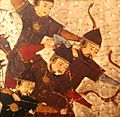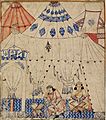Rashid al-Din Hamadani facts for kids
Rashīd al-Dīn Ṭabīb (Persian: رشیدالدین طبیب; 1247–1318), also known as Rashīd al-Dīn Faḍlullāh Hamadānī, was an important leader, historian, and doctor in Ilkhanate Iran. He was born in 1247 in Hamadan to a Persian Jewish family.
When he was about 30 years old, in 1277, Rashid al-Din became a Muslim. He then rose to become a powerful vizier (a high-ranking government official) for the Ilkhan ruler, Ghazan. Ghazan later asked him to write a huge book called Jāmiʿ al-Tawārīkh. This book is now seen as the most important source for learning about the Ilkhanate period and the Mongol Empire. Rashid al-Din stayed as a vizier until 1316.
He was accused of a serious crime against the Ilkhanid king Öljaitü and died in 1318.
Historian Morris Rossabi called Rashid al-Din "probably the most important person in Persia during Mongol rule." He wrote many books and started a special learning center called the Rab'-e Rashidi in Tabriz.
Contents
Life Story
Rashid al-Din was born into a Persian Jewish family in Hamadan. His grandfather worked for Hulagu Khan, who founded the Ilkhanate. Rashid al-Din's father was a pharmacist at the court. Rashid al-Din became a Muslim when he was about thirty.
He trained as a doctor and began working for Hulagu's son, Abaqa Khan. He became the Grand Vizier (a very high official) of the Ilkhanid court in Soltaniyeh. He served as a vizier and doctor for the Ilkhan rulers Ghazan and Öljaitü. Later, during the rule of Abu Sa'id Bahadur Khan, he faced problems at court and died when he was seventy. His son, Ghiyas al-Din ibn Rashid al-Din, also served as a vizier for a short time after him.
The Book Jāmiʿ al-Tawārīkh
The Jāmiʿ al-Tawārīkh means "Compendium of Chronicles." Ghazan asked Rashid al-Din to write this book. At first, it was meant to be a history of the Mongols and their rulers. But it grew to include the history of the whole world, from the time of Adam up to Rashid al-Din's own time.
Rashid al-Din got help from Bolad, a Mongol nobleman. Bolad was a messenger from the Great Khan to the Ilkhanid court. He gave Rashid al-Din a lot of information about the Mongols.
The Compendium was finished between 1307 and 1316, during the rule of Öljaitü.
Writing Workshop: Rab' i-Rashidi
The book was created at a special writing workshop called Rab'-e Rashidi in Qazvin. Many skilled writers and artists worked there. They made beautiful books with many pictures. These books could also be copied accurately using a printing method from China.
The Jāmiʿ al-Tawārīkh was a very large book when it was finished around 1307. Some parts of it have been lost or have not been found yet. Parts of the book that still exist have amazing pictures. People believe these were made when Rashid al-Din was alive and perhaps under his direct watch at the Rab'-e Rashidi workshop.
Why the Book is Important
The first two volumes of the Jāmiʿ al-Tawārīkh are still around. They are very important for studying the Ilkhanate. Volume I tells the history of the Turkish and Mongol tribes. It includes their old stories, family trees, and the history of Mongol conquests from Genghis Khan to Ghazan Khan. Volume II describes the history of all the people the Mongols fought or met.
For the history up to Möngke Khan (1251–1259), Rashid al-Din used Ata-Malik Juvayni as his main source. But he also used many other sources from far-off lands that are now lost. The Jāmiʿ al-Tawārīkh is probably the most complete Persian book about the Mongol period. For the time of Genghis Khan, he used a lost book called Altan Debter ("Golden Book"). His writing about the Ilkhanid period might show some bias because he was a high official himself. Still, it is seen as the most valuable written source for that time.
The third volume of the book is either lost or was never finished. It was supposed to be about "historical geography."
One of the most important things about the Jāmiʿ al-Tawārīkh is how it shows the mixing of cultures. This mixing led to the greatness of the Persian and Ottoman Empires. Many ideas from this time were passed to Europe and helped start the Renaissance. This happened because the Mongol Empire was so large. Rashid al-Din's book clearly shows this. The text talks about different peoples the Mongols met. It is one of the first attempts to tell history from a worldwide view, not just one culture's view. The Jāmiʿ tried to give a history of the whole world at that time, even though many parts are now lost.
One part of the Jāmiʿ al-Tawārīkh is a long History of the Franks (1305/1306). This part might have used information from Europeans who worked for the Ilkhanates. It gives a good description of Europe's government, how Italian mariners used maps, and the timelines of kings.
Sharing the Book: Printing and Translation
Rashid al-Din also put all his writings into one book called Jami' al-Tasanif al-Rashidi ("The Collected Works of Rashid"). It included maps and pictures. He even had some of his shorter books, about medicine and government, translated into Chinese. Anyone who wanted to could read his works and copy them. To help with this, he set aside money to pay for two complete copies of his works to be made each year, one in Arabic and one in Persian.
Who Wrote It?
Some people have wondered if Rashid al-Din was the only author of the Jāmiʿ al-Tawārīkh.
Abu al-Qasim Kashani (who died in 1324) wrote an important book about Öljaitü. He said that he was the real author of the Jāmiʿ al-Tawārīkh. He claimed Rashid al-Din took all the credit and money for it.
However, according to Encyclopædia Iranica, there is little doubt that Rashid al-Din was the main author. But the book is generally seen as a team effort, with help from research assistants. Kashani might have been one of these helpers.
Some also thought the book was a translation of an original Mongol text.
Later Life and Death
In 1312, his colleague Sa'd-al-Din Mohammad Avaji lost his power. Taj-al-Din Ali-Shah Jilani took his place. Then, in 1314, Öljaitü died, and his son, Abu Sa'id Bahadur Khan, became ruler. Abu Sa'id sided with Ali-Shah. In 1318, Rashid al-Din was accused of a very serious crime against Öljaitü. He died on July 13, at the age of seventy.
His belongings were taken away. The Rab'-e Rashidi workshop, with its valuable books, was given to the Mongol soldiers. About a hundred years later, during the time of Timur's son Miran Shah, Rashid al-Din's bones were moved from the Muslim cemetery to the Jewish cemetery.
His Ideas About His Country
Rashid al-Din loved his country, Iran. He also admired Iran's old traditions of government. The name "Iran" is mentioned in his Jami' al-tawarikh. He also showed that he did not like the Mongols, whom he called Turks.
See also
 In Spanish: Rashid-al-Din Hamadani para niños
In Spanish: Rashid-al-Din Hamadani para niños
- List of Muslim historians
- List of Persian scientists and scholars
- Ghiyas al-Din ibn Rashid al-Din, his son
Images for kids
-
Genghis Khan (center) at the coronation of his son Ögedei, from Rashid al-Din's work.
-
Hulagu Khan with his Eastern Christian wife, Doquz Khatun. From Rashid al-Din's work.







